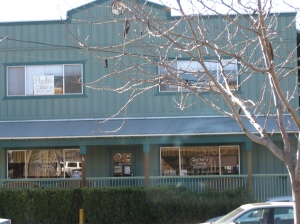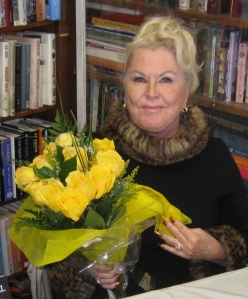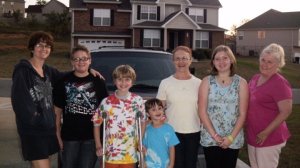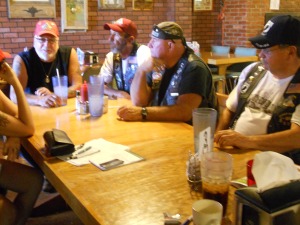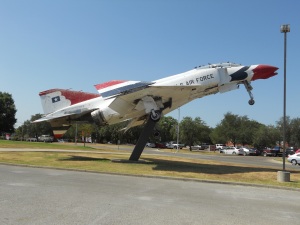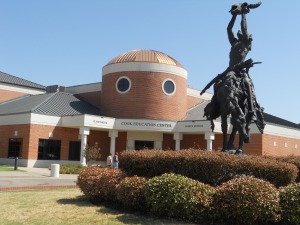This week I discovered the local chapter of Quilts of Valor. They meet in the back of the Quilter’s Coop in Temecula, California, every Friday of the year, unless something like Temecula’s Rod Run makes it difficult.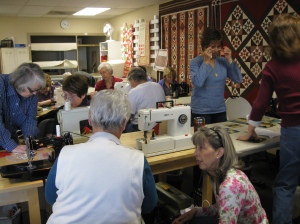
Norma Enfield and Beverly Packard were making quilts for years and sending them to Camp Pendleton but they felt a little lost because they really never got any feedback. Norma discovered the organization Quilts of Valor in 2008, and realized at that time there were very few chapters in California. She decided to concentrate on veterans and their families, and started QOVFTemecula. At first they met at Quilters Coop at the old location . Three years ago they followed the store when they moved to Old Town Front Street, at the corner of Third Street. “We are so relieved to not have to carry our sewing machines upstairs every week!”
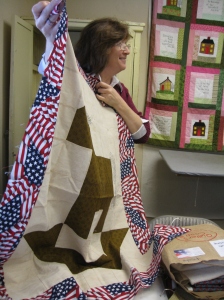
A new pattern!
Norma keeps a record of each quilt given away in a scrapbook binder. There are presently around thirty veterans on the waiting list to receive a quilt of their own. Living WWII vets get moved to the head of the line. To get a vet on the waiting list, pick up a form at the Quilters Coop or from any of the lady volunteers and fill it out with full name of the vet, branch of service, last job title/rank, deployment (Korea, Vietnam, Afghanistan, or here at home), whether wounded, dates of service, and who to notify when quilt is ready for pick-up. This local chapter requires a photo of the service person in uniform, which goes with the picture of the quilt in the chapter’s scrapbook, but this information is private and will not be shared with others. Some of the info will be put on the label on the back of the quilt.
Anyone is welcome to drop by, and if you can’t or don’t sew, you can iron pieces, sort fabric and help in many other ways. On a side shelf there is a box of squares with a blank white center on which anyone can write a message to the veterans, from a simple “Thank You” to a long tribute. A tribute can name a particular veteran, or be to all service members. You can sign your tribute or leave it as coming from all Americans. These squares are incorporated into a specific finished quilt.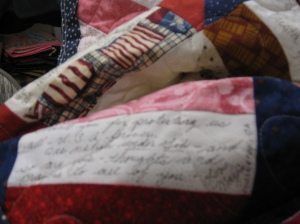
Beverly Packard comes from Fallbrook every Friday. Others drive in from such places as Hemet, Murrieta, Corona and Nuevo. In 2011, the group made 139 baby, child and teenager quilts, and 151 adult quilts. All the women bring their own sewing machines. Norma takes the fabrics that are donated, sorts them out and assigns projects. They make blocks and see if there are colors missing or needed, and then they go shopping. What a convenience sewing in the back of a nice large quilt shop! The group keeps multiple three-ring binders containing patterns that they’ve developed. They are always looking for more.
Some of the women put together squares (or blocks) in the store on Fridays. Kathleen started as a presser and is now learning to sew. Beverly Packard mostly does bindings on the finished quilts “because I’m fast and the others tend to get stressed out on them”. Some people pick up “star kits” and take them home to work on in their own spare time. Beverly told me she kept making “stars”, figuring she’d piled up enough to keep busy, and then the next Friday she’d come in and find them all gone. She couldn’t figure out where they were disappearing to, until she realized women were coming in during the week and taking “stars” home to work on and bring back finished.
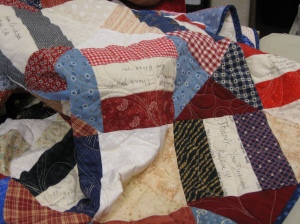 Norma says that their biggest bottleneck is the actual quilting – the sewing of the three layers together, top, batting, and backing. Some of the baby, and children quilts can be done on a regular sewing machine, but the larger adult quilts need a quilting machine, which is quite large and can take up a whole car space in a garage. “If we could find more machine quilters, we could pass out more quilts!” So not only can they use help with piecing blocks and tops, but desperately need more machine quilters to quilt the three layers together. The group provides everything the quilter needs to quilt the quilt. They provide their own thread and skills to machine-quilt each adult quilt.
Norma says that their biggest bottleneck is the actual quilting – the sewing of the three layers together, top, batting, and backing. Some of the baby, and children quilts can be done on a regular sewing machine, but the larger adult quilts need a quilting machine, which is quite large and can take up a whole car space in a garage. “If we could find more machine quilters, we could pass out more quilts!” So not only can they use help with piecing blocks and tops, but desperately need more machine quilters to quilt the three layers together. The group provides everything the quilter needs to quilt the quilt. They provide their own thread and skills to machine-quilt each adult quilt.
Baby, children and teenager quilts are turned over to the project coordinator of Project Linus in San Diego who makes sure that this local chapter’s quilts go to the children of veterans who are staying at Balboa Naval Hospital in San Diego.
Most of the ladies have their own reasons for participating in this group. Norma says that she is too old to join the military, but she can make them quilts! “There is just tremendous personal rewards in making a Veteran feel like his time in the service really meant something. This is our way of showing them that we care and want to give them some handmade love to wrap themselves up in. Every single thank-you note is kept in the group’s notebooks.”
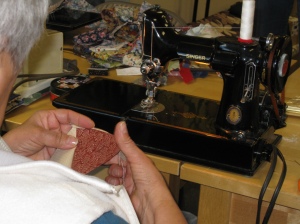
Reminds me of my grandmother's machine
Philomina has been coming for three months and works on a 1951 Centennial Singer model. She came to the US as a teenager from Portugal and when she graduated from high school, she was all set to become an airline stewardess so she could see the world. The problem was, in those days airlines had strict criteria for their “girls”. For one thing, you had to be 5-foot two inches, and Nina was only 5-foot, one and a half inches! So instead, she joined the US Marines and saw the world that way (after foot-blistering boot camp at Perris Island).
Kathy Turley was an Air Force service member for almost fifteen years. She is a Vietnam era veteran, but women didn’t go to Vietnam when she was in. Like the others, she has stories to tell. For instance: right away she was taught to march in formation, and then right after that, she was expected to attend a class on how to “walk like a lady”! However, her group got called up for duty at the last minute. “So,” she says, “I never did learn how to walk like a lady!”
Teresa Ontiveros is not a veteran, at least not a veteran of formal service. Instead, she walked for two days and three nights to enter the United States from Mexico. She learned English and learned to drive so she could hold down a job. In Mexico, she was a teacher, but when she entered the US, she could only be certified as having a high school education. So she went to the University of California to become a certified teacher. She is now a citizen and visibly proud to be an American. “I’m free,” she said. “I have a wonderful life and I don’t have to be afraid anymore. Making these quilts is my way to give back to the guys who make this country what it is.”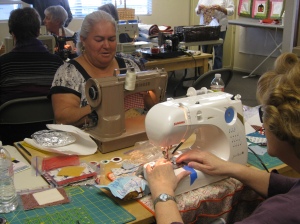
The group gladly accepts donations of good quality cotton fabric, red, white, tan, cream and blues. Any bright, colorful, children’s novelty cotton fabric is also appreciated. All monetary donations are tax deductible as this is a 501 (c) (3) non-profit organization.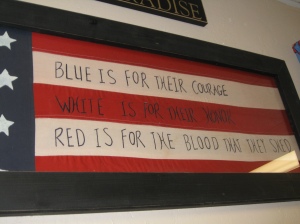
So come in to the Quilter’s Coop at 28677 Old Town Front Street on Fridays from ten A.M. until around two in the afternoon. Ask questions, check out their work, help out, donate, pick up a form to put your veteran on the list, or just stop by and say “Hi!”
